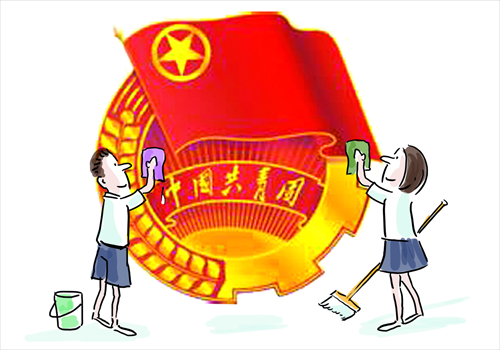Soviet youth league offers warning lesson

Illustration: Liu Rui/GT
The discussions about how to deepen reforms in the Communist Youth League in China have never ended. In this regard, the experience of the All-Union Leninist Communist Youth League in the Soviet Union can be used as a reference.
Since the Youth League in the Soviet Union assumed its name in 1926, it had played an active role for a long period in mobilizing young people to take part in public affairs, economic development and social service. Members of the Youth League made contributions to a series of well-known projects in the 1930s such as the Dneprodzerzhinsk Hydropower Station, the Turkestan-Siberia Railway, the Ural Heavy Machine Building Plant and the Stalingrad Tractor Factory.
After World War II, about 500,000 Youth League members and talented young people went to the eastern and northern parts of the Soviet Union to assist in constructing major industrial bases. Around 350,000 young people made great efforts in the uncultivated land in the Far East to provide a large amount of food for the country.
Meanwhile, the Soviet Union attached importance to Communism, patriotism and collectivism. It also set up the Young Guard and military schools for teenagers, the latter of which still functions so far.
However, in the later stage of the Soviet Union, the cultivation of youth and the development of the Youth League saw a trend of weakening and laxity. Cronyism prevailed in the education system. The corruption and luxury life of the offspring of high-level officials such as Leonid Brezhnev severely tarnished the image of the Youth League and the Communist Party of the Soviet Union.
After Mikhail Gorbachev became leader, the number of Youth League members began to decrease. The young people held a passive view toward Communist ideas and non-governmental anti-Communist youth organizations started to jump. Against the backdrop of democratization, marketization and Westernization, some Youth League officials either engaged in business or indulged in their official perks.
In the later rule of Gorbachev, the Communist Party of the Soviet Union took the initiative to set up some joint ventures and some government management departments gradually became commercialized. With the support of the central committee of the Soviet Communist Party, the Youth League branches at different levels served as pioneers in this commercial wave.
A few years later, these Youth League officials rode the wave of economic reforms and some even emerged as financial giants. Exiled businessman Mikhail Khodorkovsky was one of them. Statistics in the late 1990s showed that Youth League officials made up as much as 17 percent of the Russian business elite.
In 1990, the Soviet Youth League was dissolved. But none of the officials felt grieved, but instead took bold steps in the later liberalization and privatization wave and made a big fortune. The different departments within the international branch of the central committee of the Youth League even turned into foreign trade administrations.
The situation improved only after Vladimir Putin took control of the country. To cope with the impact of the Color Revolution and "liberal" forces, Putin began to resume Soviet traditions by establishing Nashi youth organizations, setting up youth summer camps and revived the Stalin-era fitness program from the 1930s called "Ready for Labor and Defense."
Moreover, by drawing on the lessons of the Soviet Union, Putin enhanced educational equity and implemented unified national colleague entrance examinations to curb corruption in this field.
When the Soviet Youth League was dedicated to patriotism and contribution, it can be a source of enormous passion and creativity. But when it detached itself from the youth and the people, it lost its direction and vitality. The history of the Soviet Youth League offers a rich political example, which is worthy of analysis and research.
The author is director of the Institute of Information Studies at the Chinese Academy of Social Sciences and chief editor of Social Sciences Abroad. opinion@globaltimes.com.cn